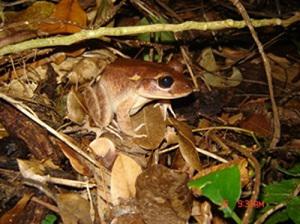Edward Narayan
Other projects
16 Nov 2009
Annual Assessment of Chytrid Fungus Prevalence amongst Endangered Native Fijian Ground Frog Populations on Viwa – Fiji Islands
13 Jul 2011
Community Led Exclusion of Invasive Cane Toads from Breeding Sites of the Endangered Fijian Ground Frog (Platymantis vitiana) on Viwa, Fiji Islands
This project aims to carryout detailed monitoring of the annual variation in the reproductive status of endangered Fijian ground frog Platymantis vitianus, within selected cane toad Bufo marinus accessible and cane toad inaccessible “out of bound” natural habitats, on Viwa Island-Fiji.

Fijian ground frog.
Fijian ground frog Platymantis vitianus (Anura, Ranidae) is currently listed as endangered by the IUCN (World Conservation Union) standards. Despite the rapid in-situ declines of P. vitianus, scientific knowledge on their reproductive biology remains anecdotal. This unique project involves an annual assessment of the variation(s) of reproductive status of P. vitianus on Viwa Island (located 900m east off first mainland Viti Levu), on which small mammalian invasive species eradication projects are currently underway (Morley, 2007).

Fijian ground frog
A potential benefit to the local people of Viwa Island will be recruitment of field assistant(s), who will assist in conducting field surveys. A primary objective of this project is to find out the reproductive variation(s) of P. vitianus between breeding and non-breeding seasons, potential in-situ nesting areas, number of eggs incubated, hatchability rates, number of gravid females present at invasive cane toad Bufo marinus [CT] accessible habitat site vs. CT inaccessible “out of bounds” habitat site and to identify possible physical and biological factors affecting the incubation and hatchability rates of froglets.
This project incorporates various scientific tools for data analysis and it carries out three main comparisons including (a) Variation in the total number of P. vitianus from each of the categories i.e. adult male, adult non-gravid female, adult gravid female, metamorphs and froglets in both selected habitat locations i.e. cane toad accessible and cane toad inaccessible sites, over a twelve month period. (b) Variations in reproduction i.e. comparison of the total numbers of gravid females, metamorphs, nesting areas between breeding vs. non-breeding season (if found) and between the two habitat locations. (c) Calculate the average monthly growth rates of as many froglets found in the two habitat locations.
Ultimately this project will provide a detailed account of the total number of potential nesting sites, egg clutches, number of eggs per clutch and egg, froglet biometrics of P. vitianus found in both natural habitat sites. This annual project will provide substantial new baseline scientific data on reproductive status of P. vitianus on Viwa Island and it will help determine whether this unique frog has a high rate of reproductive failure. Furthermore, it will provide new information on the possible effect(s) of introduced cane toad on the reproductive efforts of P. vitianus. The main benefit of knowing more about the reproductive status of P. vitianus will be towards its overall conservation and safeguarding it from extinction crisis.